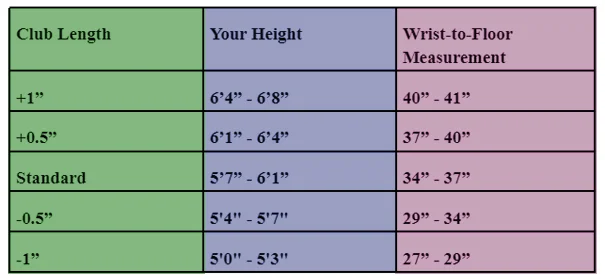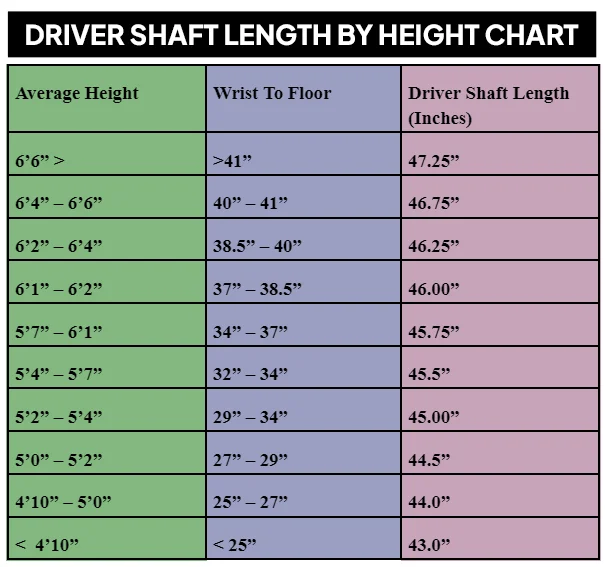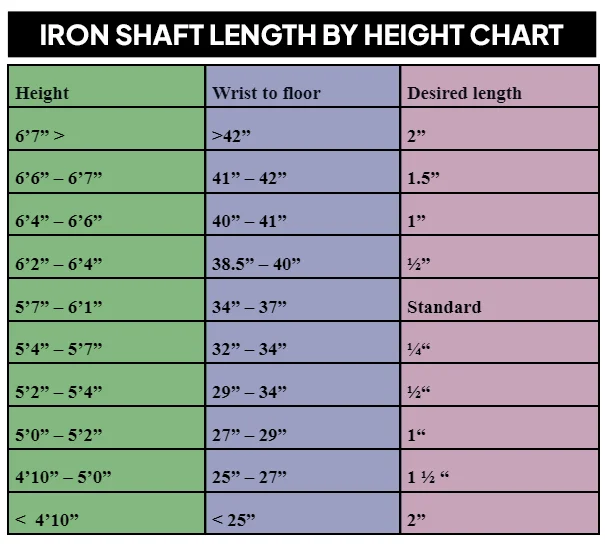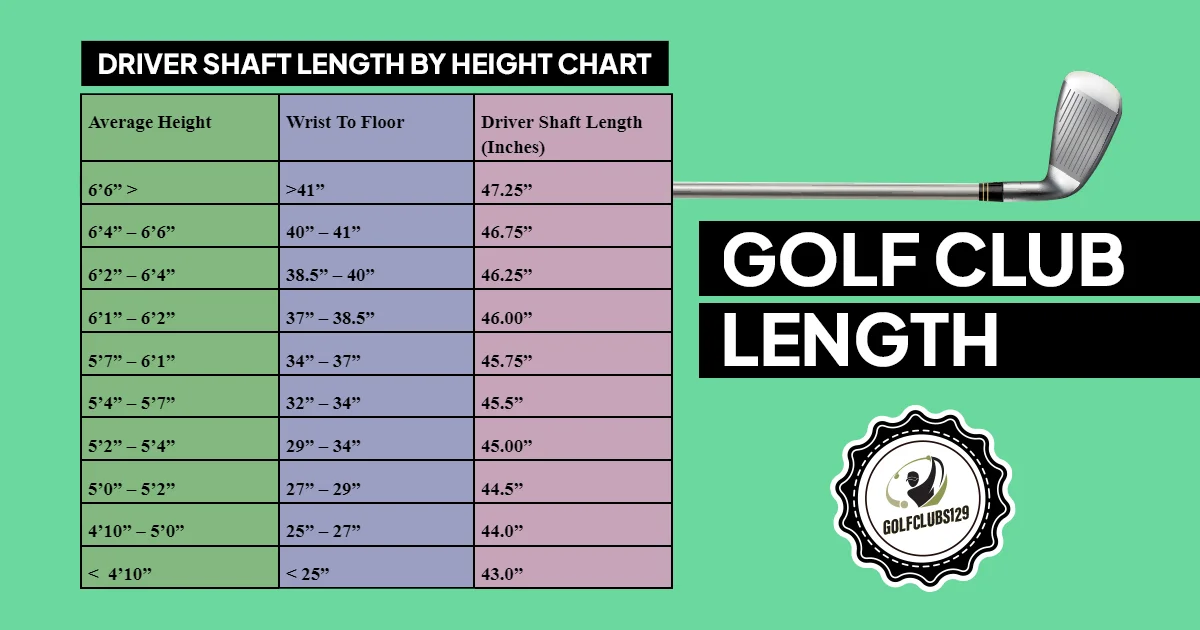Struggling with inconsistent shots or discomfort during your swing? The issue might not be your skill—it could be your golf club length.
Many golfers overlook how critical club length is to performance. But here’s the truth: a club that’s too long or too short can seriously throw off your posture, swing path, and impact point, leading to poor accuracy and lost distance. Just like you wouldn’t buy a suit without tailoring it to your size, you shouldn’t settle for off-the-rack clubs—especially if you’re significantly taller or shorter than average.
However, the relationship between a golfer’s height and club length is fundamental. And when your equipment fits your body correctly, your swing feels natural, more repeatable, and significantly more effective.That’s why it’s important to explore options like the Best Golf Clubs for Short Men or the Best Golf Clubs for Tall Men, which are specifically designed for comfort, control, and performance.
Moreover, It’s also helpful to understand the different Types of Golf Clubs and how length varies between drivers, irons, wedges, and putters. Each club serves a unique purpose—and using the right length enhances its performance.
In this guide, our golf experts break down the 10 key factors that determine ideal club length—plus, we’ve included a handy golf club length chart to help you make confident decisions when buying or adjusting your clubs. Whether you’re a beginner or an experienced player, understanding club length could be the game-changer you’ve been looking for. If your are video lover you can also watch our video by end of this article……
Importance of Golf Club Length:
The length of your club or shaft determines the comfort and efficiency of your game. When you play with the wrong golf club length, you will subconsciously compensate for your play style. If the club is too short for your body, you will spend hours hunched over, paying for a lack of power with heavier swings than usual.
On the other hand, if the club is shorter, you will find yourself standing up too straighter than you need to and struggling to drive the ball with control. The correct club length will allow you to assume the most comfortable stance swing with the appropriate power and control.
Additionally, shaft flexibility affects the power and precision of your swing, so getting it right along with the club length will certainly enhance your golf game. Moreover, read our expert guide on Which golf club hits the ball with the highest launch angle?
10 Key Factors | How to Choose the Right Golf Club Length?
Choosing the right golf club length isn’t just about comfort—it directly impacts your posture, swing mechanics, and shot consistency. Here’s a detailed guide based on expert fitting standards to help you find your ideal club length.
1. Your Height (Starting Point, Not the Rule)
While height gives a general idea of club length, it’s not enough alone. For example:
- Players over 6’2” often need clubs 0.5″ to 1″ longer than standard.
- Players under 5’6” may benefit from slightly shorter clubs.
But height must be combined with wrist-to-floor measurement.
2. Wrist-to-Floor Measurement (Most Accurate)
This is the gold standard for determining club length.
How to measure: Stand straight in your golf shoes and measure from your wrist crease (where your hand bends) to the floor.
This measurement tells fitters how long your arms are relative to your height and how the club should sit at address.
3. Your Posture at Setup
Some players naturally stand more upright or bend more at the hips when addressing the ball. This affects:
- How the club interacts with the turf
- Whether the club feels too long or short even if it’s “standard”
A custom fitting adjusts for your natural posture.
4. Arm Length
If you have long arms, you might need shorter clubs—even if you’re tall. Shorter arms? You may need a bit more length to avoid crouching.
5. Swing Mechanics and Tempo
Your swing speed and control level matter:
- Fast/aggressive swingers often prefer shorter clubs for more control.
- Smooth swingers may benefit from longer clubs to gain distance.
6. Skill Level
Beginners often benefit from slightly shorter clubs that are easier to control. For experienced players, the right length maximizes shot precision and consistency.
7. Club Type (One Size Doesn’t Fit All)
Different clubs have different standard lengths. A custom fit considers:
- Driver: Longest club in your bag
- Irons: Mid-length for balanced control and distance
- Wedges: Shortest clubs for accuracy in short game
8. Lie Angle Adjustments
Changing the club’s length affects its lie angle—how the sole rests on the ground. A club that’s too long will sit “toe-up,” pushing shots left; too short sits “heel-up,” often pushing right.
Professional fitting adjusts both length and lie angle together.
9. Age and Physical Limitations
- Juniors need clubs sized to their growth stage.
- Seniors may benefit from slightly longer clubs for easier reach, especially if flexibility is limited.
10. Get Professionally Fitted
Even skilled players can struggle with off-the-shelf clubs. A professional club fitting:
- Uses tools like launch monitors and swing analyzers
- Accounts for body size, swing mechanics, playing style, and goals
- Helps avoid costly guesswork
Pro tip: Most local golf shops or ranges offer affordable fitting sessions—often discounted if you buy clubs there.
How Do You Measure the Golf Club Length?
The length of a golf club is usually based on a player’s height, but a few other things can affect it, like how long your wrist is from the clubface to the floor or even what kind of club you’ll be using. We stick to our motto that golf isn’t complicated; it’s simple.
Static Measurement
The initial step in determining the optimal length of your golf club is to determine your height. You are likely already aware of your height; however, if you have embellished it on your online dating profile, it may be beneficial to re-take your measurements.
Height is the most straightforward way to determine the ideal length of your club, particularly for those new to golf. If you are satisfied that your height determines your club length, scroll down to the next page of this article to discover the optimal shaft length for your golf club.
Wrist-to-Floor Measurement
The height of the player typically determines the length of the golf club. However, wrist-to-foot measurements are the most precise for club fitting, as they consider how far the golfer will be holding their clubs from the ground.
Therefore, golfers with arms that are longer or shorter than their height may not be misfitted by selecting clubs based solely on height. If the golfer has shorter arms, they may need to use clubs longer than the height would suggest. Conversely, if the golfer has long arms as opposed to their size, they may be better off selecting a shorter club.
Stand on a flat surface, with your arms naturally at your sides, and wear the shoes you will golf in. Have a friend measure you from wrist crease to floor.
View the golf club length chart below to determine the optimal length for your club.

Driver Shaft Length
Drivers are designed to make you swing faster and farther. Generally, a longer shaft will give you a stronger swing and more distance. That’s why most golf clubs come with a 45-inch shank, two inches longer than the standard 43-inch shank from years ago.
But shaft length isn’t the only thing that affects your swing. It’s hitting the ball in the right spot on the club face that gives you the most distance. Many PGA pros will use a shorter shank than the standard one because they want more control and intuition over their swing.
But if you’re starting or playing intermediate golf, it’s best to stick with the standard length or whichever works best for you.

Iron Shaft Length
Irons already come with different shaft lengths. The 9-iron has a minimum length of 35 inches and a maximum length of 35.5. Starting with the 9-iron, the length increases by half a step until it reaches a 2-iron height.
That half a degree can make all the difference in the world when you have clubs that are the wrong length for you (or even too short). As we mentioned earlier, the wrong size of the golf club can mess with your game. That’s why choosing the correct iron length is so important.

Fitting process for Women Golfers
The fitting process for women is the same as for men. However, the standard length of golf clubs is typically one inch shorter than the typical length of men’s clubs. Consequently, the only difference is the expected length of clubs. Don’t miss our detailed guide on Best golf clubs for senior women.
Conclusion
For those golfers who are simply attempting to determine the correct length of their club, the above two static measurements can be easily completed at home. The total height of the club and the measurement from wrist to floor can then be used to identify the correct length of the club.
However, for those looking for a more comprehensive and accurate fitting process, it is recommended to seek the services of a qualified professional who can consider the dynamic aspects outlined above and include these static measurements in the overall process.
Frequently Asked Questions
How do I know the length of my golf club?
Before the grip installation, the golf club length can be determined. It is often done because the thickness of the grip at the end can vary from model to model, thus eliminating any uncertainty.
How long is the average golf club length for a male?
A male’s average golf club length is typically 36.5″ compared to 38.25″ for a female.
Do graphite shafts have to be longer?
The answer is usually yes. The manufacturer usually makes the length longer to compensate for the swing weight difference. Graphite irons are usually ¼ to ½” longer than steel, and woods are usually ½ to 1″ longer than steel (if that’s an option).


